|
|
|
JANSSON (Johannes).
[TOSCANE] Nova & accurata Tusciæ antiquæ descriptio. Autore Ab. Ortelio.
[Amsterdam, 1657-1658]. 347 x 494 mm.
Bookseller reference : LBW-2962
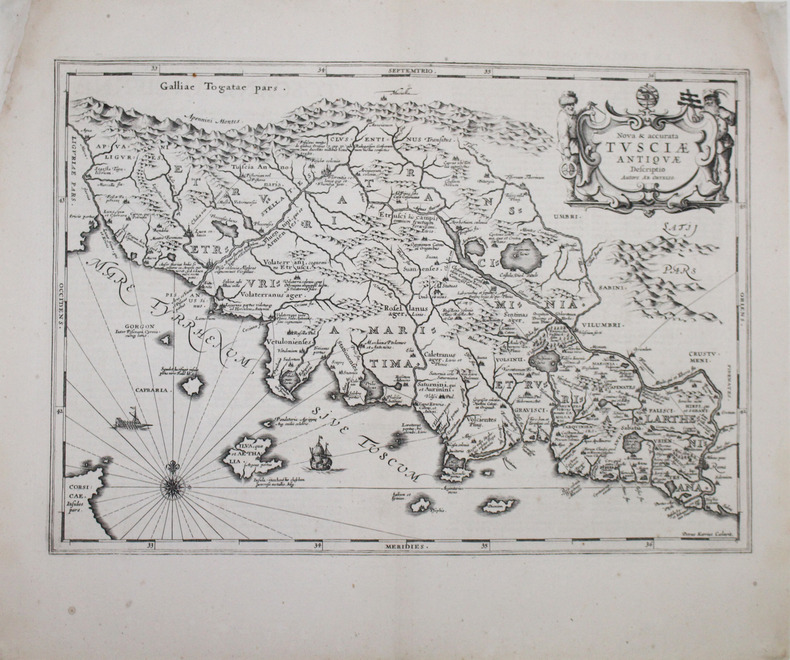
|
|
|
JANSSON (Johannes).
Sinus Gangeticus vulgo Golfo de Bengala nova descriptio.
[Amsterdam, 1657]. 470 x 542 mm.
Bookseller reference : LBW-2938
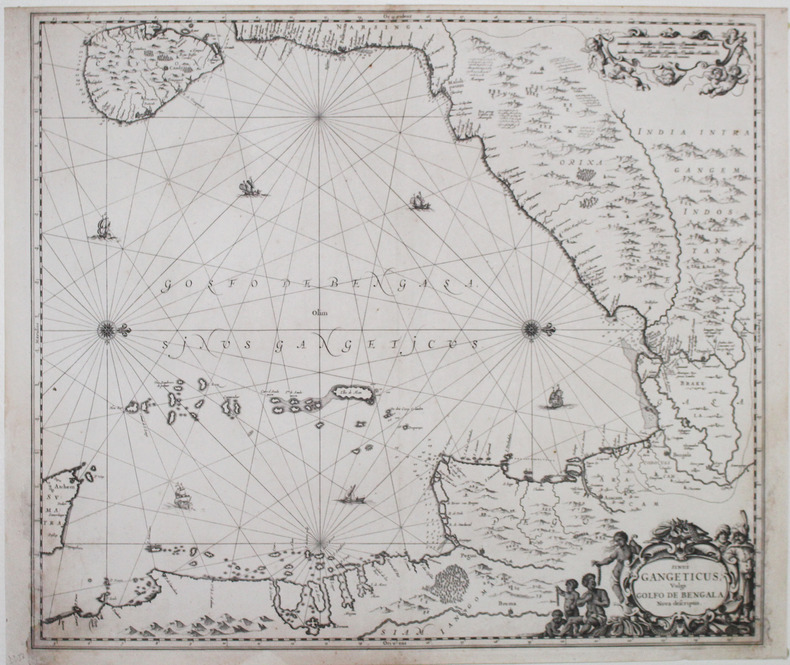
|
|
|
JANSSON (Johannes).
Turcicum Imperium.
[Amsterdam, circa 1640]. 410 x 517 mm.
Bookseller reference : LBW-6792
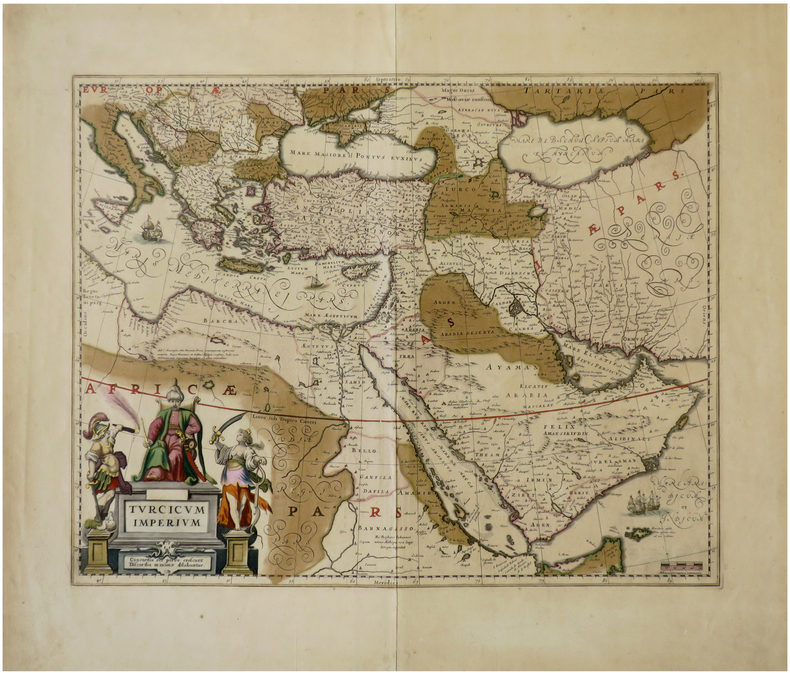
|
|
|
Jansson, Jan
Nobilis Fluvius Albis maximâ curâ, ex variis famosisque Auctoribus collectus, et in lucem editus. Zweigeteilte in Kupfer gestochene Elbkarte auf 1 Blatt.
[Frankfurt am Main, Merian, 1637]. Je Darstellung 17,5 x 51,5 cm. Fachmännisch gerahmt 56,5 x 65,5 cm (Flachgoldleiste 3,5 cm breit).
Bookseller reference : 84923

|
|
|
JANSSONIUS Joannes (cartographe) - DUVAL Pierre, secrétaire de Monseigneur lévesque dAire
Carte de "LÉVESCHÉ D'AIRE" tracé par le Sieur Pierre du Val, secrétaire de Monseigneur lévesque dAire [circa 1680]
Amsterdam JANSSONIUS Joannes 1658 une carte ancienne gravée sur cuivre (Copper etching) en noir et couleurs d'Epoque. Format : 44,5 cm de haut x 55 cm de large, pli central vertical normal venant d'un atlas( horizontal centerfold), texte en latin au verso, carte ornée de 4 cartouches richement ornés de 20 angelots et dun paysan entrain de ramasser des pommes. carte double page gravée et colorée à la main d'époque, provenance : "Atlas novus, sive theatrum orbis terrarum : In quo Galliae, Helvetiae(Volume II)", 1658 Amsterdam JANSSONIUS Joannes Editeur,
Bookseller reference : 24912
|
|
|
JANSSONIUS Johannes (1588-1664)
Aegyptus Antiqua divisa in Nomos. Authore P. Duval Abbeviliense…
Orientata con il Nord a destra, la mappa raffigura nel dettaglio la regione compresa tra la valle del Nilo e il Mar Rosso. Dall'Atlas MajorDoppio cartiglio, uno per il titolo e uno per la dedica in francese a "A Monsieur Monsieur Doviat Sgr. de Montreuille, Con.er du Roy, et Maistre Ordinaire en sa Chambre des Comptes Par son Très humble et obéisant Serviteur P. Duval Géographe de sa Maiesté". Johannes Janssonius, figlio dell'editore di Arnhem Jan Janssen, sposò Elisabeth Hondius, figlia di Jodocus Hondius, ad Amsterdam nel 1612. Dopo il suo matrimonio, si stabilì in questa città come libraio ed editore di materiale cartografico. Nel 1618 si stabilì ad Amsterdam accanto alla libreria di Willem Jansz. Blaeu, entrando in una seria competizione. Le sue attività non riguardavano solo la pubblicazione di atlanti e libri, ma anche di mappe singole e un vasto commercio di libri con filiali a Francoforte, Danzica, Stoccolma, Copenaghen, Berlino, Koningsbergen, Ginevra e Lione. Nel 1631 iniziò a pubblicare atlanti insieme a Henricus Hondius. Nei primi anni 1640 Henricus Hondius lasciò l'attività di pubblicazione di atlanti completamente a Janssonius. La concorrenza con Joan Blaeu, figlio e successore di Willem, nella produzione di atlanti spinse Janssonius ad ampliare il suo Atlas Novus finalmente in un'opera di sei volumi, in cui furono inseriti un atlante marino e un atlante del Vecchio Mondo. Dopo la morte di Joannes Janssonius, il negozio e la casa editrice furono continuati dagli eredi sotto la direzione di Johannes van Waesbergen (c. 1616-1681), genero di Joannes Janssonius. Le matrici degli atlanti di Janssonius furono in seguito vendute a Schenk e Valck. Map oriented with north on the right. It presents a colorful and detailed picture of the region between the fertile Nile River valley and the Red Sea. The map is adorned with a strapwork title cartouche with a credit to Pierre du Val. Includes a note in a decorative cartouche: "A Monsieur Monsieur Doviat Sgr. de Montreuille, Con.er du Roy, et Maistre Ordinaire en sa Chambre des Comptes Par son Très humble et obéisant Serviteur P. Duval Géographe de sa Maiesté".Published in Janssonius' Atlas Major. Johannes Janssonius (Arnhem, 1588-1664), son of the Arnhem publisher Jan Janssen, married Elisabeth Hondius, daughter of Jodocus Hondius, in Amsterdam in 1612. After his marriage, he settled down in this town as a bookseller and publisher of cartographic material. In 1618 he established himself in Amsterdam next door to Blaeu’s book shop. He entered into serious competition with Willem Jansz. Blaeu.. His activities not only concerned the publication of atlases and books, but also of single maps and an extensive book trade with branches in Frankfurt, Danzig, Stockholm, Copenhagen, Berlin, Koningsbergen, Geneva, and Lyon. In 1631 he began publishing atlases together with Henricus Hondius. In the early 1640s Henricus Hondius left the atlas publishing business completely to Janssonius. Competition with Joan Blaeu, Willem’s son and successor, in atlas production prompted Janssonius to enlarge his Atlas Novus finally into a work of six volumes, into which a sea atlas and an atlas of the Old World were inserted. After the death of Joannes Janssonius, the shop and publishing firm were continued by the heirs under the direction of Johannes van Waesbergen (c. 1616-1681), son-in-law of Joannes Janssonius. The copperplates from Janssonius’s atlases were afterwards sold to Schenk and Valck. Van der Krogt 1

|
|
|
JANSSONIUS Johannes (1588-1664)
Antiqua Urbis Roma Imago Accuratissima…
Grande pianta della città stampata su due fogli, ispirata alla celebre carta del Pirro Ligorio del 1561.Questa straordinaria ricostruzione di Roma durante il regno di Augusto, arricchita da una cospicua legenda con 269 richiami, costituisce il lavorò più ambizioso contenuto nel Civitates Orbis Terrarum, del quale oltretutto è una delle sole tre mappe a doppio foglio. Incisione in rame, finemente colorata a mano, in eccellente stato di conservazione. Opera tratta dal "Theatrum praecipuarum urbium" celebre teatro delle città del Janssonius, sullo stile del "Civitates Orbis Terrarum" di Braun & Hogenberg. La raccolta, pubblicata ad Amsterdam tra il 1652 ed il 1657, contiene 500 tavole raffiguranti città di ogni parte del mondo. Contrariamente al lavoro degli acerrimi rivali Blaeu, Janssonius si servì per la realizzazione dell'opera delle lastre di precedenti cartografi ed editori. In particolare nel 1653 egli acquisto da Abraham Hogenberg le lastre del "Civitates orbis Terrarum" che incorporò nella sua opera, ristampandole, con alcune modifiche. Per le piante delle città olandesi, ordinò delle nuove lastre basate sull'atlante che Johannes Blaeu diede alla luce nel 1649. Per molte delle opere contenute nel 5° volume, quello dedicato all'Italia e denominato "Theatrum celebriorum urbium Italiae..", si servì delle lastre realizzate da Jodocus Hondius per l'opera "Italia Hodierna.." del 1627. Nella pianta di Roma antica cambia il decoro del cartiglio in alto, mentre in basso ai lati del cartiglio sono aggiunte dei personaggi. Incisione in rame, finemente colorata a mano, in ottimo stato di conservazione. Map of the city printed on two sheets, inspired by the famous work by Pirro Ligorio, printed by Michele Tramezzino in 1561. This extraordinary reconstruction of Rome during the reign of Augustus, enriched by a conspicuous legend with 269 references, constitutes the most ambitious work contained in the Civitates Orbis Terrarum, of which it is one of only three double-sheet maps. Work taken from the "Theatrum praecipuarum urbium" famous theatre of the cities of Janssonius, in the style of Braun & Hogenberg's "Civitates Orbis Terrarum". The collection, published in Amsterdam between 1652 and 1657, contains 500 plates depicting cities from all over the world. Janssonius used the plates of previous cartographers and publishers to create the work. In particular, in 1653 he bought the plates of the "Civitates orbis Terrarum" from Abraham Hogenberg, who incorporated them into his work and reprinted them with some modifications. For many of the works contained in the 5th volume, the one dedicated to Italy and called "Theatrum celebriorum urbium Italiae...", he used the plates made by Jodocus Hondius for the work "Italia Hodierna..." of 1627. In the map of ancient Rome the decoration of the cartouche at the top changes, while at the bottom at the sides of the cartouche are added characters. Copper engraving, finely coloured by hand, in excellent condition.

|
|
|
JANSSONIUS Johannes (1588-1664)
Argonautica
Carta storico/geografica tratta dall'atlante di Georgius HORNIUS "Accuratissima orbis antiqui delineatio sive Geographia vetus sacra & profana", per la prima volta edito nel 1653. Le carte derivano da quelle di Ortelius, pubblicata nel "Parergon". Mappa dei viaggi di Giasone e degli Argonauti, mostra il Mediterraneo e il Mar Nero con specifico riferimento al percorso dell'Argo, seguendo principalmente la linea temporale e la geografia delle Argonautiche di Apollonio di Rodi. Molti degli elementi più fantastici del mito sono anche tracciati, tra cui le Symplegades o 'Rocce Erranti' all'imboccatura del Bosforo del Mar Nero, i mostri Scilla e Cariddi su entrambi i lati dello Stretto di Messina, l'isola di Eea casa della strega Circe al largo della costa napoletana, l'isola della ninfa Calipso al largo della costa calabrese meridionale, il paradisiaco Giardino delle Esperidi sulla costa settentrionale dell'Africa, e le città della Colchide sul Mar Nero, casa della futura moglie di Giasone, Medea, e del famoso Vello d'oro. Johannes Janssonius, figlio dell'editore di Arnhem Jan Janssen, sposò Elisabeth Hondius, figlia di Jodocus Hondius, ad Amsterdam nel 1612. Dopo il suo matrimonio, si stabilì in questa città come libraio ed editore di materiale cartografico. Nel 1618 si stabilì ad Amsterdam accanto alla libreria di Willem Jansz. Blaeu, entrando in una seria competizione. Le sue attività non riguardavano solo la pubblicazione di atlanti e libri, ma anche di mappe singole e un vasto commercio di libri con filiali a Francoforte, Danzica, Stoccolma, Copenaghen, Berlino, Koningsbergen, Ginevra e Lione. Nel 1631 iniziò a pubblicare atlanti insieme a Henricus Hondius. Nei primi anni 1640 Henricus Hondius lasciò l'attività di pubblicazione di atlanti completamente a Janssonius. La concorrenza con Joan Blaeu, figlio e successore di Willem, nella produzione di atlanti spinse Janssonius ad ampliare il suo Atlas Novus finalmente in un'opera di sei volumi, in cui furono inseriti un atlante marino e un atlante del Vecchio Mondo. Dopo la morte di Joannes Janssonius, il negozio e la casa editrice furono continuati dagli eredi sotto la direzione di Johannes van Waesbergen (c. 1616-1681), genero di Joannes Janssonius. Le matrici degli atlanti di Janssonius furono in seguito vendute a Schenk e Valck. Incisione in rame, finemente colorata a mano, in buone condizioni. Map taken from the HORNIUS, Georgius"Accuratissima orbis antiqui delineatio sive Geographia vetus sacra & profana" first published in Amsterdam in 1653. After Ortelius' map published in the "Parergon". Map of the journeys of Jason and the Argonauts, shows the Mediterranean and Black Sea with specific reference to the path of the Argo, mainly following the timeline and geography of Apollonius of Rhodes' Argonautica. Many of the myth's more fantastical elements are also plotted, including the Symplegades or 'Wandering Rocks' at the Bosporus mouth of the Black Sea, the monsters Scylla and Charybdis on either side of the Straits of Messina, the island of Aeaea home of the witch Circe off the Neapolitan coast, the island of the nymph Calypso off the southern Calabrian coast, the paradisiacal Garden of the Hesperides on the northern coast of Africa, and the cities of Colchis on the Black Sea, home of Jason's future wife Medea and the famous Golden Fleece. Johannes Janssonius (Arnhem, 1588-1664), son of the Arnhem publisher Jan Janssen, married Elisabeth Hondius, daughter of Jodocus Hondius, in Amsterdam in 1612. After his marriage, he settled down in this town as a bookseller and publisher of cartographic material. In 1618 he established himself in Amsterdam next door to Blaeu’s book shop. He entered into serious competition with Willem Jansz. Blaeu.. His activities not only concerned the publication of atlases and books, but also of single maps and an extensive book trade with branches in Frankfurt, Danzig, Stockholm, Copenhagen, Berlin, Koningsbergen, Geneva, and Lyon. In 1631 he began publishing atlases together with Henricus Hondius. In the early 1640s Henricus Hondius left the atlas publishing business completely to Janssonius. Competition with Joan Blaeu, Willem’s son and successor, in atlas production prompted Janssonius to enlarge his Atlas Novus finally into a work of six volumes, into which a sea atlas and an atlas of the Old World were inserted. After the death of Joannes Janssonius, the shop and publishing firm were continued by the heirs under the direction of Johannes van Waesbergen (c. 1616-1681), son-in-law of Joannes Janssonius. The copperplates from Janssonius’s atlases were afterwards sold to Schenk and Valck. Copperplate with fine later hand colour, in good conditions.

|
|
|
JANSSONIUS Johannes (1588-1664)
Erythraei Sive Rubri Maris Periplus
Carta storico/geografica tratta dall'atlante di Georgius HORNIUS "Accuratissima orbis antiqui delineatio sive Geographia vetus sacra & profana", per la prima volta edito nel 1653. Le carte derivano da quelle di Ortelius, pubblicata nel "Parergon". Un'insolita e attraente mappa del 1658 dell'Oceano Indiano, o Mare Eritreo, come era nell'antichità. Composta da Jan Jansson ispirandosi alla carta molto simile del 1597 pubblicata da A. Ortelius nel suo Parergon. Copre dall'Egitto e la valle del Nilo verso est passando per l'Arabia e l'India, fino al sud-est asiatico e Java. Cartograficamente, India, Arabia e Africa corrispondono approssimativamente alle convenzioni del periodo. Il sud-est asiatico è meno riconoscibile, ma la penisola malese, Sumatra e Giava sono chiaramente indicate. La maggior parte dei nomi dei luoghi utilizzati sono derivati da Tolomeo, che ha basato la sua descrizione della regione sulle registrazioni delle conquiste di Alessandro Magno. Due mappe più piccole nei quadranti superiore sinistro e destro sono di eccezionale interesse. La carta in alto a sinistra mostra l'Africa nord-occidentale ed è intitolata "Annonis Periplus". Questo è un riferimento alle leggendarie spedizioni del re cartaginese Hanno, che si dice sia stato il primo ad accedere all'Oceano Indiano navigando intorno alla punta meridionale dell'Africa. Per inciso, durante il viaggio, si dice anche che sia stato il primo a domare un leone. La carta in alto a destra mostra le regioni polari settentrionali come erano percepite all'epoca. Una massa che copre la calotta polare è identificata come "Hyperborea". A sinistra di questa, più o meno dove si trova oggi il Nord America, appare l'isola di Atlantide; mentre la Scizia, l'Europa (Thule) e l'Asia sono sulla destra. La Groenlandia e forse l'Islanda appaiono in basso. Questa mappa ha lo scopo di indicare la possibilità di un passaggio a nord-est verso l'Asia, che all'epoca era attivamente ricercato dai navigatori olandesi, inglesi e russi. Johannes Janssonius, figlio dell'editore di Arnhem Jan Janssen, sposò Elisabeth Hondius, figlia di Jodocus Hondius, ad Amsterdam nel 1612. Dopo il suo matrimonio, si stabilì in questa città come libraio ed editore di materiale cartografico. Nel 1618 si stabilì ad Amsterdam accanto alla libreria di Willem Jansz. Blaeu, entrando in una seria competizione. Le sue attività non riguardavano solo la pubblicazione di atlanti e libri, ma anche di mappe singole e un vasto commercio di libri con filiali a Francoforte, Danzica, Stoccolma, Copenaghen, Berlino, Koningsbergen, Ginevra e Lione. Nel 1631 iniziò a pubblicare atlanti insieme a Henricus Hondius. Nei primi anni 1640 Henricus Hondius lasciò l'attività di pubblicazione di atlanti completamente a Janssonius. La concorrenza con Joan Blaeu, figlio e successore di Willem, nella produzione di atlanti spinse Janssonius ad ampliare il suo Atlas Novus finalmente in un'opera di sei volumi, in cui furono inseriti un atlante marino e un atlante del Vecchio Mondo. Dopo la morte di Joannes Janssonius, il negozio e la casa editrice furono continuati dagli eredi sotto la direzione di Johannes van Waesbergen (c. 1616-1681), genero di Joannes Janssonius. Le matrici degli atlanti di Janssonius furono in seguito vendute a Schenk e Valck. Incisione in rame, finemente colorata a mano, in buone condizioni. Map taken from the HORNIUS, Georgius"Accuratissima orbis antiqui delineatio sive Geographia vetus sacra & profana" first published in Amsterdam in 1653. After Ortelius' map published in the "Parergon". An unusual and attractive 1658 map of the Indian Ocean, or Erythraean Sea, as it was in antiquity. Composed by Jan Jansson after a similar 1597 map published by A. Ortelius in his Parergon. Covers from Egypt and the Nile valley eastward past Arabia and India, to Southeast Asia and Java. Cartographically, India, Arabia, and Africa roughly correspond to the conventions of the period. Southeast Asia is less recognizable, but the Malay Peninsula, Sumatra, and Java are clearly noted. Most of the place names used throughout are derived from Ptolemy, who himself based his description of the region heavily on records from Alexander the Great's conquests. Two smaller maps in the upper left and right quadrants are of exceptional interest. The upper left chart shows northwestern Africa and is titled 'Annonis Periplus.' This is a reference to the legendary expeditions of the Carthaginian King Hanno, said to have been the first to access the Indian Ocean by sailing around the southern tip of Africa. Incidentally, en route, he is also said to have been the first to tame a lion. The upper right chart shows the northern polar regions as they were perceived at the time. A landmass covering the polar ice cap is indentified as 'Hyperborea.' To the left of this, roughly where North America rests today, the island of Atlantis appears; while Scythia, Europe (Thule) and Asia are on the right. Greenland and possibly Iceland appear at the bottom. This map is intended to point out the possibility of a Northeast Passage to Asia, which was at the time being actively sought after by Dutch, English, and Russian navigators. Johannes Janssonius (Arnhem, 1588-1664), son of the Arnhem publisher Jan Janssen, married Elisabeth Hondius, daughter of Jodocus Hondius, in Amsterdam in 1612. After his marriage, he settled down in this town as a bookseller and publisher of cartographic material. In 1618 he established himself in Amsterdam next door to Blaeu’s book shop. He entered into serious competition with Willem Jansz. Blaeu.. His activities not only concerned the publication of atlases and books, but also of single maps and an extensive book trade with branches in Frankfurt, Danzig, Stockholm, Copenhagen, Berlin, Koningsbergen, Geneva, and Lyon. In 1631 he began publishing atlases together with Henricus Hondius. In the early 1640s Henricus Hondius left the atlas publishing business completely to Janssonius. Competition with Joan Blaeu, Willem’s son and successor, in atlas production prompted Janssonius to enlarge his Atlas Novus finally into a work of six volumes, into which a sea atlas and an atlas of the Old World were inserted. After the death of Joannes Janssonius, the shop and publishing firm were continued by the heirs under the direction of Johannes van Waesbergen (c. 1616-1681), son-in-law of Joannes Janssonius. The copperplates from Janssonius’s atlases were afterwards sold to Schenk and Valck. Copperplate with fine later hand colour, in good conditions.

|
|
|
JANSSONIUS Johannes (1588-1664)
Insularum Britannicarum acurata delineatio ex Geographicis Conatibus Abrahami Ortelii
Mappa realizzata da Jansson delle antiche Isole Britanniche, così come si presentavano durante il terzo e il quarto secolo, che include un cartiglio decorativo con il titolo, navi a vela e un mostro marino.Sono presenti nomi di storici siti d'epoca romana, tra cui il muro di Adriano e il muro di Pio. Incisione di Peter Van Den Keere, preparata da Ortelius. Ortelius divide l'intera isola in Britannia Maior (le attuali Inghilterra, Galles e Cornovaglia) e Britannia Minor (Scozia). Joannes Janssonius, figlio dell'editore di Arnhem Jan Janssen, sposò Elisabeth Hondius, figlia di Jodocus Hondius, ad Amsterdam nel 1612. Dopo il suo matrimonio, si stabilì in questa città come libraio ed editore di materiale cartografico. Nel 1618 si stabilì ad Amsterdam accanto alla libreria di Willem Jansz. Blaeu, entrando in una seria competizione. Le sue attività non riguardavano solo la pubblicazione di atlanti e libri, ma anche di mappe singole e un vasto commercio di libri con filiali a Francoforte, Danzica, Stoccolma, Copenaghen, Berlino, Koningsbergen, Ginevra e Lione. Nel 1631 iniziò a pubblicare atlanti insieme a Henricus Hondius. Nei primi anni 1640 Henricus Hondius lasciò l'attività di pubblicazione di atlanti completamente a Janssonius. La concorrenza con Joan Blaeu, figlio e successore di Willem, nella produzione di atlanti spinse Janssonius ad ampliare il suo Atlas Novus finalmente in un'opera di sei volumi, in cui furono inseriti un atlante marino e un atlante del Vecchio Mondo. Dopo la morte di Joannes Janssonius, il negozio e la casa editrice furono continuati dagli eredi sotto la direzione di Johannes van Waesbergen (c. 1616-1681), genero di Joannes Janssonius. Le matrici degli atlanti di Janssonius furono in seguito vendute a Schenk e Valck. Scarce first state of Jansson's map of the Ancient British Isles as seen during the third and fourth centuries.. Includes decorative cartouche, sea monstersa and 7 sailing vessels. Roman place names as well as Hadrian's Wall and the Wall of Pius appear on the map, identifying the era represented. Engraved by Peter Van Den Keere. Prepared by A.Ortelius. Ortelius divides the entire island into Britannia Maior (present day England, Wales and Cornwall) and Britannia Minor (present day Scotland). Joannes Janssonius (Arnhem, 1588-1664), son of the Arnhem publisher Jan Janssen, married Elisabeth Hondius, daughter of Jodocus Hondius, in Amsterdam in 1612. After his marriage, he settled down in this town as a bookseller and publisher of cartographic material. In 1618 he established himself in Amsterdam next door to Blaeu’s book shop. He entered into serious competition with Willem Jansz. Blaeu.. His activities not only concerned the publication of atlases and books, but also of single maps and an extensive book trade with branches in Frankfurt, Danzig, Stockholm, Copenhagen, Berlin, Koningsbergen, Geneva, and Lyon. In 1631 he began publishing atlases together with Henricus Hondius. In the early 1640s Henricus Hondius left the atlas publishing business completely to Janssonius. Competition with Joan Blaeu, Willem’s son and successor, in atlas production prompted Janssonius to enlarge his Atlas Novus finally into a work of six volumes, into which a sea atlas and an atlas of the Old World were inserted. After the death of Joannes Janssonius, the shop and publishing firm were continued by the heirs under the direction of Johannes van Waesbergen (c. 1616-1681), son-in-law of Joannes Janssonius. The copperplates from Janssonius’s atlases were afterwards sold to Schenk and Valck.

|
|
|
JANSSONIUS Johannes (1588-1664)
Latium
Carta storico/geografica realizzata per l'atlante storico di Georgius Hornius "Accuratissima orbis antiqui delineatio sive Geographia vetus sacra & profana", per la prima volta edito nel 1653. Le carte derivano da quelle di Ortelius, pubblicata nel "Parergon". Johannes Janssonius, figlio dell'editore di Arnhem Jan Janssen, sposò Elisabeth Hondius, figlia di Jodocus Hondius, ad Amsterdam nel 1612. Dopo il suo matrimonio, si stabilì in questa città come libraio ed editore di materiale cartografico. Nel 1618 si stabilì ad Amsterdam accanto alla libreria di Willem Jansz. Blaeu, entrando in una seria competizione. Le sue attività non riguardavano solo la pubblicazione di atlanti e libri, ma anche di mappe singole e un vasto commercio di libri con filiali a Francoforte, Danzica, Stoccolma, Copenaghen, Berlino, Koningsbergen, Ginevra e Lione. Nel 1631 iniziò a pubblicare atlanti insieme a Henricus Hondius. Nei primi anni 1640 Henricus Hondius lasciò l'attività di pubblicazione di atlanti completamente a Janssonius. La concorrenza con Joan Blaeu, figlio e successore di Willem, nella produzione di atlanti spinse Janssonius ad ampliare il suo Atlas Novus finalmente in un'opera di sei volumi, in cui furono inseriti un atlante marino e un atlante del Vecchio Mondo. Dopo la morte di Joannes Janssonius, il negozio e la casa editrice furono continuati dagli eredi sotto la direzione di Johannes van Waesbergen (c. 1616-1681), genero di Joannes Janssonius. Le matrici degli atlanti di Janssonius furono in seguito vendute a Schenk e Valck. Incisione in rame, finemente colorata a mano, in ottime condizioni. Map realized for the historical atlas of Georgius Hornius "Accuratissima orbis antiqui delineatio sive Geographia vetus sacra & profana", for the first time published in 1653. Johannes Janssonius (Arnhem, 1588-1664), son of the Arnhem publisher Jan Janssen, married Elisabeth Hondius, daughter of Jodocus Hondius, in Amsterdam in 1612. After his marriage, he settled down in this town as a bookseller and publisher of cartographic material. In 1618 he established himself in Amsterdam next door to Blaeu’s book shop. He entered into serious competition with Willem Jansz. Blaeu.. His activities not only concerned the publication of atlases and books, but also of single maps and an extensive book trade with branches in Frankfurt, Danzig, Stockholm, Copenhagen, Berlin, Koningsbergen, Geneva, and Lyon. In 1631 he began publishing atlases together with Henricus Hondius. In the early 1640s Henricus Hondius left the atlas publishing business completely to Janssonius. Competition with Joan Blaeu, Willem’s son and successor, in atlas production prompted Janssonius to enlarge his Atlas Novus finally into a work of six volumes, into which a sea atlas and an atlas of the Old World were inserted. After the death of Joannes Janssonius, the shop and publishing firm were continued by the heirs under the direction of Johannes van Waesbergen (c. 1616-1681), son-in-law of Joannes Janssonius. The copperplates from Janssonius’s atlases were afterwards sold to Schenk and Valck.

|
|
|
JANSSONIUS Johannes (1588-1664)
Nova & accurata Tusciae Antiquae Descriptio
Carta storico/geografica tratta dall'atlante di Georgius HORNIUS "Accuratissima orbis antiqui delineatio sive Geographia vetus sacra & profana", per la prima volta edito nel 1653. Le carte derivano da quelle di Ortelius, pubblicata nel "Parergon". Johannes Janssonius, figlio dell'editore di Arnhem Jan Janssen, sposò Elisabeth Hondius, figlia di Jodocus Hondius, ad Amsterdam nel 1612. Dopo il suo matrimonio, si stabilì in questa città come libraio ed editore di materiale cartografico. Nel 1618 si stabilì ad Amsterdam accanto alla libreria di Willem Jansz. Blaeu, entrando in una seria competizione. Le sue attività non riguardavano solo la pubblicazione di atlanti e libri, ma anche di mappe singole e un vasto commercio di libri con filiali a Francoforte, Danzica, Stoccolma, Copenaghen, Berlino, Koningsbergen, Ginevra e Lione. Nel 1631 iniziò a pubblicare atlanti insieme a Henricus Hondius. Nei primi anni 1640 Henricus Hondius lasciò l'attività di pubblicazione di atlanti completamente a Janssonius. La concorrenza con Joan Blaeu, figlio e successore di Willem, nella produzione di atlanti spinse Janssonius ad ampliare il suo Atlas Novus finalmente in un'opera di sei volumi, in cui furono inseriti un atlante marino e un atlante del Vecchio Mondo. Dopo la morte di Joannes Janssonius, il negozio e la casa editrice furono continuati dagli eredi sotto la direzione di Johannes van Waesbergen (c. 1616-1681), genero di Joannes Janssonius. Le matrici degli atlanti di Janssonius furono in seguito vendute a Schenk e Valck. Incisione in rame, finemente colorata a mano, in buone condizioni. Map taken from the HORNIUS, Georgius"Accuratissima orbis antiqui delineatio sive Geographia vetus sacra & profana" first published in Amsterdam in 1653. After Ortelius' map published in the "Parergon". Johannes Janssonius (Arnhem, 1588-1664), son of the Arnhem publisher Jan Janssen, married Elisabeth Hondius, daughter of Jodocus Hondius, in Amsterdam in 1612. After his marriage, he settled down in this town as a bookseller and publisher of cartographic material. In 1618 he established himself in Amsterdam next door to Blaeu’s book shop. He entered into serious competition with Willem Jansz. Blaeu.. His activities not only concerned the publication of atlases and books, but also of single maps and an extensive book trade with branches in Frankfurt, Danzig, Stockholm, Copenhagen, Berlin, Koningsbergen, Geneva, and Lyon. In 1631 he began publishing atlases together with Henricus Hondius. In the early 1640s Henricus Hondius left the atlas publishing business completely to Janssonius. Competition with Joan Blaeu, Willem’s son and successor, in atlas production prompted Janssonius to enlarge his Atlas Novus finally into a work of six volumes, into which a sea atlas and an atlas of the Old World were inserted. After the death of Joannes Janssonius, the shop and publishing firm were continued by the heirs under the direction of Johannes van Waesbergen (c. 1616-1681), son-in-law of Joannes Janssonius. The copperplates from Janssonius’s atlases were afterwards sold to Schenk and Valck. Copperplate with fine later hand colour, in good conditions.

|
|
|
JANSSONIUS Johannes (1588-1664)
Roma Hodierna
Magnifica veduta a volo d'uccello di Roma con cartiglio decorativo con titolo, che mostra la città com'era nel 1550. Sono incluse varie strutture superstiti dell'antica Roma: le mura circostanti, il Pantheon, il Colosseo, l'Arco di Costantino e il Foro Romano. Nell'angolo sinistro in primo piano si possono vedere il Palazzo Papale e l'Obelisco dal circo di Caligola e Nerone. “La stampa, sebbene incisa ed edita ad Amsterdam nel 1657, riproduce Roma verso il 150, essendo copia della pianta del Braun Hogenberg, dalla quale si differenzia unicamente per i personaggi in primo piano […] In basso, entro due cartigli, una legenda di 101 numeri” (cfr. Marigliani, Le Piante di Roma, p. 153). Il modello originale è da ricercare però nella pianta di Giovanni Francesco Camocio del 1569 (o della precedente di Leon Pitor del 1568, come sostiene Scaccia Scarafoni) nella quale la città è ritratta a volo d'uccello dal Gianicolo. La pianta è inclusa nel Theatrum Celebriorum Urbium Italiae, Aliarumque In Insulis Maris Mediterranei di Janssonius, stampato ad Amsterdam nel 1657. Acquaforte e bulino, finemente colorata a mano, ossidazioni nei margini, per il resto in buono stato di conservazione. Non comune. Bibliografia Marigliani n. 53; Scaccia Scarafoni n. 165; Van der Krogt 4, 42:15. Fine example of Jansson's rare modern view of Rome, from his Theatrum Celebriorum Urbium Italiae, Aliarumque In Insulis Maris Mediterranei. Striking bird's-eye plan of Rome with decorative title cartouche, showing the city as it was c. 1550. Included are various surviving features of ancient Rome: the surrounding walls, the Pantheon, the Coliseum, the Arch of Constantine, and the Forum Romanum. In the left corner in the foreground can be seen the Papal Palace and the Obelisk from the circus of Caligula and Nero. The print, although engraved and published in Amsterdam in 1657, reproduces Rome around 1550, being a copy of Braun Hogenberg's plan, from which it differs only by the figures in the foreground [...] At the bottom, within two cartouches, a legend of 101 numbers" (cf. Marigliani, Le Piante di Roma, p. 153). The original model, however, is to be found in Giovanni Francesco Camocio's plan from 1569 (or Leon Pitor's earlier one from 1568, as Scaccia Scarafoni claims) in which the city is portrayed from a bird's eye view from the Janiculum. Jan Janssonius (also known as Johann or Jan Jansson or Janszoon) (1588-1664) was a renowned geographer and publisher of the seventeenth century, when the Dutch dominated map publishing in Europe. Born in Arnhem, Jan was first exposed to the trade via his father, who was also a bookseller and publisher. In 1612, Jan married the daughter of Jodocus Hondius, who was also a prominent mapmaker and seller. Jonssonius’ first maps date from 1616. In the 1630s, Janssonius worked with his brother-in-law, Henricus Hondius. Their most successful venture was to reissue the Mercator-Hondius atlas. Jodocus Hondius had acquired the plates to the Mercator atlas, first published in 1595, and added 36 additional maps. After Hondius died in 1612, Henricus took over publication; Janssonius joined the venture in 1633. Eventually, the atlas was renamed the Atlas Novus and then the Atlas Major, by which time it had expanded to eleven volumes. Janssonius is also well known for his volume of English county maps, published in 1646. Etching, with fine later hand colour, some foxing on the margins, otherwise good condition. Bibliografia Marigliani n. 53; Scaccia Scarafoni n. 165; Van der Krogt 4, 42:15.

|
|
|
JANSSONIUS Johannes (1588-1664)
Tabula Itineris decies mille Graecorum sub Cyro contra fratem suum Artaxerxem Regem Persarum, …
Bella carta storico-geografica che riporta il percorso dei Diecimila secondo l’Anabasi di Senofonte, ovvero la marcia da Sardi a Cunassa, e il ritorno da Cunassa in Grecia, dei mercenari greci assoldati da Ciro il giovane per usurpare il trono di Persia al fratello Artaserse.Senofonte era uno dei Diecimila.La battaglia tra i due esericti fu combattuta a Cunassa, nel 401 a.C.Anche se l'armata dei mercenari fu vittoriosa nella battaglia sostenuta a Cunassa contro l'esercito dell'imperatore, Ciro non sopravvisse allo scontro, e la sua morte privò la spedizione di ogni senso: i Greci, penetrati troppo a fondo nel territorio nemico, dovettero così ritirarsi verso un porto sicuro, in un ripiegamento che si preannunciava lunghissimo e pieno di insidie.Esemplare tratto da Accuratissima Orbis antiqui delineatio ... L'atlante del Mondo Antico di J. Janssonius, che ebbe diverse edizioni dal 1652 al 1741. Joannes Janssonius, figlio dell'editore di Arnhem Jan Janssen, sposò Elisabeth Hondius, figlia di Jodocus Hondius, ad Amsterdam nel 1612. Dopo il suo matrimonio, si stabilì in questa città come libraio ed editore di materiale cartografico. Nel 1618 si stabilì ad Amsterdam accanto alla libreria di Willem Jansz. Blaeu, entrando in una seria competizione. Le sue attività non riguardavano solo la pubblicazione di atlanti e libri, ma anche di mappe singole e un vasto commercio di libri con filiali a Francoforte, Danzica, Stoccolma, Copenaghen, Berlino, Koningsbergen, Ginevra e Lione. Nel 1631 iniziò a pubblicare atlanti insieme a Henricus Hondius. Nei primi anni 1640 Henricus Hondius lasciò l'attività di pubblicazione di atlanti completamente a Janssonius. La concorrenza con Joan Blaeu, figlio e successore di Willem, nella produzione di atlanti spinse Janssonius ad ampliare il suo Atlas Novus finalmente in un'opera di sei volumi, in cui furono inseriti un atlante marino e un atlante del Vecchio Mondo. Dopo la morte di Joannes Janssonius, il negozio e la casa editrice furono continuati dagli eredi sotto la direzione di Johannes van Waesbergen (c. 1616-1681), genero di Joannes Janssonius. Le matrici degli atlanti di Janssonius furono in seguito vendute a Schenk e Valck. Acquaforte, impressa su carta vergata coeva, finemente acquarellata, in ottimo stato di conservazione. A map of Persia, indicating major settlements, regions, and mountain ranges, as well as the march of the Ten Thousand . The Ten Thousand were a group of mercenary units, mainly Greek, drawn up by Cyrus the Younger to attempt to wrest the throne of the Persian Empire from his brother, Artaxerxes II. Their march to the Battle of Cunaxa and back to Greece (401 BC-399 BC) was recorded by Xenophon (one of its leaders) in his work, The Anabasis. This map was compliled by the French cartographer Pierre du Val, and published in Jansson's Atlas of the Antique World , Accuratissima Orbis antiqui delineatio... which went through several editions 1652-1741. Joannes Janssonius (Arnhem, 1588-1664), son of the Arnhem publisher Jan Janssen, married Elisabeth Hondius, daughter of Jodocus Hondius, in Amsterdam in 1612. After his marriage, he settled down in this town as a bookseller and publisher of cartographic material. In 1618 he established himself in Amsterdam next door to Blaeu’s book shop. He entered into serious competition with Willem Jansz. Blaeu.. His activities not only concerned the publication of atlases and books, but also of single maps and an extensive book trade with branches in Frankfurt, Danzig, Stockholm, Copenhagen, Berlin, Koningsbergen, Geneva, and Lyon. In 1631 he began publishing atlases together with Henricus Hondius. In the early 1640s Henricus Hondius left the atlas publishing business completely to Janssonius. Competition with Joan Blaeu, Willem’s son and successor, in atlas production prompted Janssonius to enlarge his Atlas Novus finally into a work of six volumes, into which a sea atlas and an atlas of the Old World were inserted. After the death of Joannes Janssonius, the shop and publishing firm were continued by the heirs under the direction of Johannes van Waesbergen (c. 1616-1681), son-in-law of Joannes Janssonius. The copperplates from Janssonius’s atlases were afterwards sold to Schenk and Valck. Koeman, C. Atlantes Neerlandici, Ja 2.

|
|
|
Janssonius, Johann
Brandenburgum Marchionatus cum Ducatibus Pomeraniae et Meklenburgi (um 1633). [Altkolorierter Kupferstich, gerahmt / handcoloured copper engraving, framed].
o.J. (Johann Janssonius, geb. 1588 in Arnhem, gest. vor dem 11. Juli 1664 in Amsterdam, eigentlich Jan Janszoon, weitere Schr
Bookseller reference : 66675CB
|
|
|
JANTON Henri
Les emplois non postaux des timbres-poste des territoires français
Le Monde des Philathélistes 1956 1956, Le Monde des Philatélistes, in-12 agrafé de 8 pages, quelques figures noir et blanc exemplaire sur papier ordinaire n°232/500. | Etat : Bon état général (Ref.: J4097)
Bookseller reference : 6787
|
|
|
JANVIER GÉOGRAPHE
CARTE DU ROYAUME DE HONGRIE DIVISÉ EN HAUTE ET BASSE HONGRIE,TRANSILVANIE, ESCLAVONIE ET CROATIE, dressé par le Sieur JANVIER GÉOGRAPHE - 1771
Paris Lattré 1771 carte ancienne colorée d'époque en vert , rouge et jaune, cartouche non coloré, gravée par Arrivet. Format total : 50 centimètres de haut par 39 centimètres de large, 1771 Paris Lattré Editeur,
Bookseller reference : 27418
|
|
|
Japan
Landkarte im Maßstab 1:3,168.000.
Ldn., Edward Stanford o. J. (um 1890). Flächenkol., lithogr. Landkarte in 20 Teile zerschnitt. u. auf Leinen aufgezogen, in Leporellofaltung, Ln.-Mappe m. aufkasch. Deckelbildchen der Fa. George Philip & Son, London, eine Teilkartenrückseite u. Innendeckel m. gefedertem Vorsatzpapier beklebt, am Einbd. geringe Gebrauchsspuren, am re. Kartenrand Klebeet. d. Fa. George Philip & Son, Map, Chart, and Geographical Depot London, Karte in sehr gutem Zustand.
Bookseller reference : KART0060

|
|
|
Japanese Hand Coloured Wood Block Printing; Maps and Atlases; Tokyo Map Hyoshiya Ichirobe
WOODBLOCK HAND-COLOURED MAP OF TOKYO; JAPAN EIRI EDO OEZU Illustrated Edo
Edo Tokyo: Hyoshiya Ichirobe Hayashi-shi Yoshinaga First month 1684 But Third month 1680. A large woodcut map of Edo Tokyo with fine handcolouring on joined and folded paper. The map is breathtaking in its detail and features many paintings of important landmarks temples bridges and people who are often pictured working or fishing from boats on the waterways running through Tokyo. A stunning and very rare woodblock map beautifully and unusually handcoloured. Roads blocks buildings open areas canals and waterways are all vividly laid out on this huge and most impressive map. 123.5 by 149.5 cm. folded within paper covers folds to 28 by 18 cm now preserved in a fine clamshell box. A remarkably well preserved and very rare item with some light rubbing due to age and as to be expected. A bit of old worming or light soiling and occasional small repairs but in all quite astonishing in its quality and beautifully preserved with bright and vivid colour and detail. AN EXTRAORDINARY ITEM REMARKABLE FOR BOTH ITS CARTOGRAPHIC DETAIL AND ITS ARTISTIC BEAUTY. The wood block printing shows land tenures of Daimyo and Hatamoto. It also shows temples and shrines includes a distance chart and descriptive listing of Daimyo showing crests and halberds. There is also a inset of the eastern portion of Edo. Hyoshiya Ichirobe (Hayashi-shi Yoshinaga) unknown
Bookseller reference : 24285

|
|
|
Jason, David with Edworthy, Niall
David Jason - In His Element
No marks or inscriptions. No creasing to covers or to spine. A lovely clean crisp very tight copy with bright unmarked boards and no bumping to corners. Dust jacket not price clipped or torn or creased. 160pp. David Jason takes the reader to some of the most exotic locations on the planet as he indulges in his passion for diving.

|
|
|
JAÏS Pierre et LAHANA Henri
"Bridge simple et moderne; enfin l'espéranto du bridge : la méthode de la longue d'abord."
Paris, René Julliard, 1970. 14 x 21, 277 pp., cartonnage d'édition + jaquette, bon état.
Bookseller reference : 34019
|
|
|
JAÏS Pierre et LEBEL Michel
La majeure cinquième, la nouvelle bible du bridge. Collection les bases du bridge moderne.
Editions du Rocher, 1976. 13 x 20, 409 pp., très nombreux exemples, broché, bon état.
Bookseller reference : 21215
|
|
|
JBPhillips; Illustrator Maps J. B.
the young church in action
Geoffrey Bles 1955. Hardcover. Used; Good. Dust jacket torn. <p><i><strong>Fast Dispatch. Expedited UK Delivery Available. Excellent Customer Service. </strong></i> <br/><br/>Bookbarn International Inventory #2994466</p> Geoffrey Bles hardcover
Bookseller reference : 2994466
|
|
|
JEAN (Pierre).
[JEU de l'OIE] Jeu royal et géographique des départemens de la France.
Paris, Jean, [1814-1815]. 508 x 638 mm.
Bookseller reference : LBW-8542

|
|
|
JEAN (Pierre).
[LYON] Plan de la ville de Lyon et de ses environs.
Paris, Jean, 1840. En 21 sections montées sur toile et pliées, formant un plan de 582 x 905 mm ; étiquette au dos avec titre manuscrit.
Bookseller reference : LBW-6111
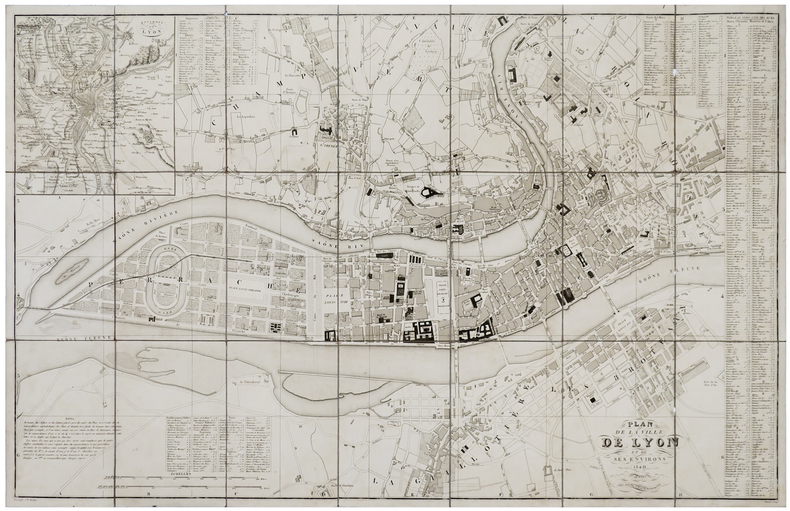
|
|
|
Jean Paul Kauffmann; Illustrator Maps
Voyage to Desolation Island
Harvill Press 2001. Hardcover. Good. Harvill Press hardcover
Bookseller reference : SONG1860469264 ISBN : 1860469264 9781860469268

|
|
|
Jean TRANIE - Juan Carlos CARMIGNIANI - illustrations par Louis de BEAUFORT - cartes par Colonel MICHALON
Napoléon et l'Autriche - La Campagne de 1809, de TRANIE & CARMIGNIANI
1979 Copernic Diffusion - 1979 - 1 ère edition - In-4, 27,2 x 25,9 x 2,8 cm - Cartonnage éditeur sous jaquette illustrée- illustrations NB et couleurs, certaines PP - Bel exemplaire - Réf. 47118
Bookseller reference : 47118
|
|
|
Jean-Jacques Barthélémy & Jean-Denis Barbié du Boccage (pour les cartes)
Lettre autographe + Voyage du jeune Anacharsis en Grèce, dans le milieu du quatrième siècle avant l'ère vulgaire.
Paris, de Bure, 1788. Demi-basane, 7 volumes in-8 & 1 volumes in-4, XIV-382-[2]; [6]-568-[2]; [6]-560-[2]; [6]-564-[2]; [6]-543-[3]; 511 et [6]-130-CCCXXII-[2]p & XLIIp-31 cartes. Edition originale au format in-8, complète de TOUS ses volumes et TOUTES ses cartes. L'ouvrage, dû à l'abbé Barthélémy, décrit au travers d'un voyage prêté au philosophe Anacharsis, la Grèce et ses monuments au 4e siècle avant Jésus-Christ. L'ouvrage est illustré de 31 cartes dépliantes (format in-4, 26.5*21.5cm) faites par Jean-Denis Barbié du Boccage, qui travaillait alors avec Barthélémy. L'ouvrage est ENRICHI d'une très rare lettre de l'abbé Barthélémy, lettre autographe non signée, justement écrite à Barbié du Boccage. Cette lettre, simplement datée du "lundy 24 janv." date de 1785 (le contenu de la lettre comme là mention du lundi confirme cette année). Il s'agit probablement de la PREMIERE LETTRE envoyée par Barthélémy à la nouvelle recrue du Cabinet des Médailles car Barbié du Boccage y arrive début 1785. La lettre dit précisément : "Je crains, Monsieur, que vous ne soyez malade et j'envoie savoir de vos nouvelles. Si vous pouvez venir demain, nous irons chez M. Le Noir pour vous présenter à lui" Jean-Charles-Pierre Le Noir, garde de la bibliothèque du Roi depuis 1784 démissionnera durant l'année 1785. Cette mention d'une présentation confirme donc bien l'arrivée très récente de Barbié du Boccage. Reliure demi-basane vers 1850, dos lisse, filets dorés, beau papier (vélin?) bien conservé, grandes marges, rares rousseurs ou petites taches, quelques cartes tachées (mouillure claire visible au dos des cartes, vraisemblablement avant la reliure). Il manque en revanche les XVIII premières pages d'introduction de l'Atlas, qui reste néanmoins complet de TOUTES les cartes. Bel ensemble, très rare avec une lettre autographe de l'abbé Barthélémy.
Bookseller reference : 002450
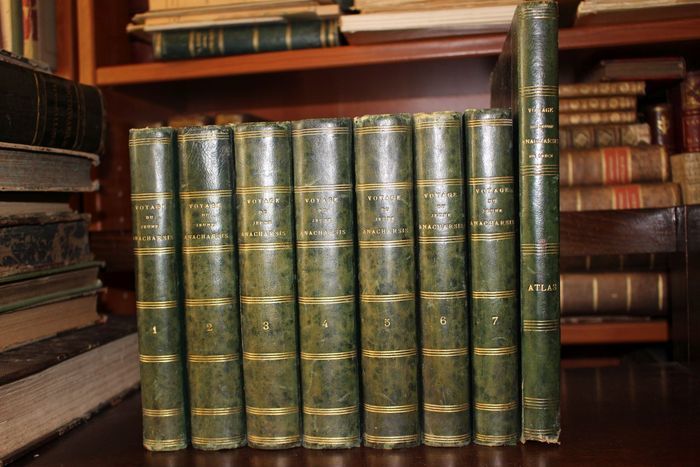
|
|
|
Jean-Marie LHOTE
Les TAROTS
Un ouvrage de 89 pages, format 200 x 295 mm, illustré, relié cartonnage couleurs, publié en 1978, Editions Atlas, bon état
Bookseller reference : LFA01368
|
|
|
Jean-Pierre Seguin et Cécile de Jandin (Catalogue rédigé par) ; Julien Cain et Jean Adhémar (introduction de)
Cinq siècles de cartes à jouer en France. Bibliothèque nationale Galerie Mansart Septembre- Octobre 1963
Paris, bulletin du Vieux Papier / Fascicule 205 , 1963 0 un fascicule in-4°, 93 pp., couverture illustrée. (pages légèrement cornées). 423 n° décrits. Quelques illustrations en noir. Complet du feuillet d'errata. Peu courant.
Bookseller reference : 024951
|
|
|
JEFFERYS (Thomas).
[CAEN] Plan of the city and castle of Caen.
[London, 1774]. 187 x 251 mm.
Bookseller reference : LBW03d3d
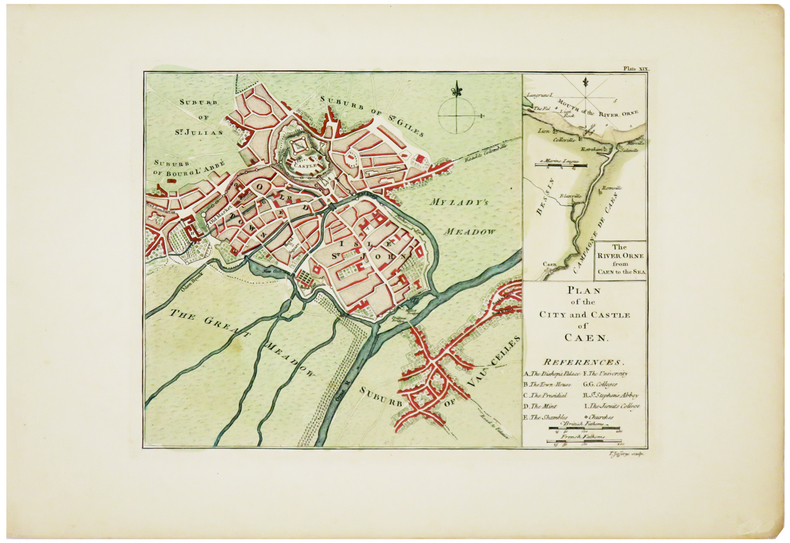
|
|
|
JEFFERYS (Thomas).
[PROVENCE] 15th chart of the coast of France from Aigues Mortes to Brégançon.
London, 1774. 180 x 248 mm.
Bookseller reference : LBW03d44
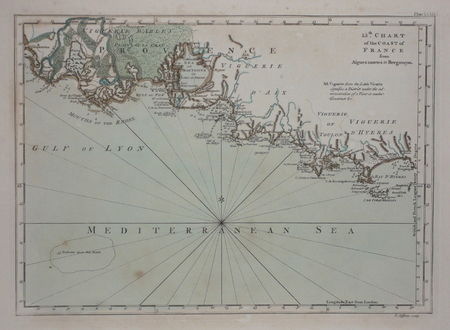
|
|
|
JEFFERYS (Thomas);
[ABBEVILLE] Plan of the city and fortifications of Abbeville.
London 1774 187 x 251 mm.
Bookseller reference : LBW03d46
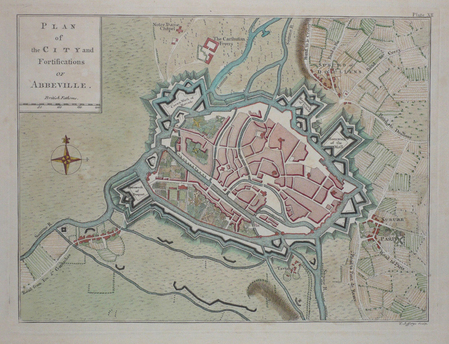
|
|
|
JEFFERYS (Thomas);
[AGDE] Plan of the town and mole of Agde with the fort de Brescou.
London 1774 197 x 276 mm.
Bookseller reference : LBW03d43
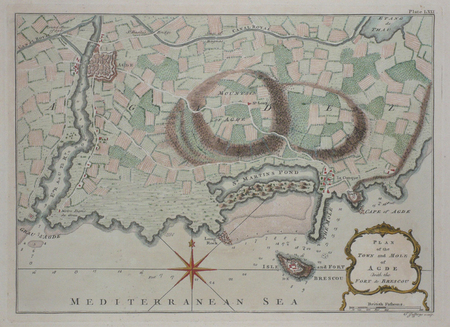
|
|
|
JEFFERYS (Thomas);
[DIEPPE] Plan of Dieppe with the new fortifications and projected works.
London 1774 209 x 312 mm.
Bookseller reference : LBW03d47
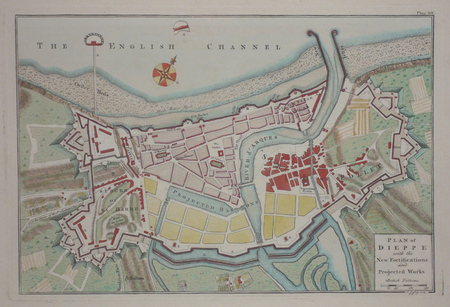
|
|
|
JEFFERYS (Thomas);
[GRAVELINES] A plan of Gravelines, with the new canal and the course of the river Aa to the sea.
London 1774 189 x 250 mm.
Bookseller reference : LBW03d42

|
|
|
JEFFERYS (Thomas);
[NORMANDIE] 5th chart of the coast of France, from Fécamp to Cape Barfleur.
London 1774 180 x 248 mm.
Bookseller reference : LBW03d48
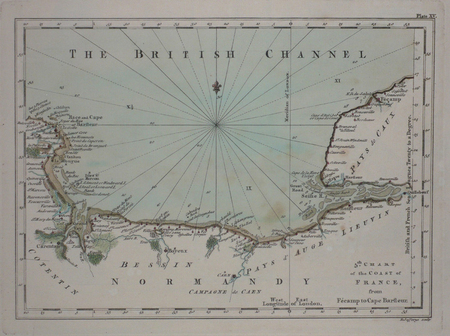
|
|
|
Jefford, Andrew
Peat Smoke and Spirit : A Portrait of Islay and Its Whiskies
No marks or inscriptions. A very clean very tight copy with unmarked black cloth boards and no bumping to corners. Dust jacket not price clipped or marked or torn or creased with minor traces of storage. 406pp. History of the Scottish Isle of Islay and its whisky. The Island is home to seven of the world's most widely admired malt whisky distilleries on its shores and this study provides a most detailed analysis of Scotch malt whisky production. Maps on end papers.

|
|
|
Jenichen Balthasar (attivo dal 1560, morto nel 1599)
Roma
La rarissima veduta aerea di Roma di Balthasar Jenichen, pubblicata a Norimberga. La veduta di Jenichen deriva a sua volta da una xilografia della Cosmographia di Sebastian Münster (Basilea, 1550), che raffigura Roma così com'era intorno al 1490 (Per la veduta di Münster si veda A. Frutaz, Le piante di Roma, XCVIII)."Orientata con nord in basso. A proiezione obliqua; veduta prospettica. È una ripetizione del panorama comparso la prima volta col Bergomensis (1490) e, con lievi modificazioni, ripetuto poi nello Schedel, nel Munster e in altre edizioni tutte inspirate al panorama, detto di Mantova, e che rappresenta Roma sotto il Pontificato di Alessandro VI. Forse lo Jenicken ricalca un vecchio rame senza mai aver visto Roma, sicché non riesce ad interpretare la linea della cupola del Pantheon, colloca l'Aventino presso la Porta del Popolo e qua e là dissemina altri errori topografici. L'assenza del Colosseo ricollega la presente pianta più direttamente al Munster" (cfr. Scaccia Scarafoni, p. 74)."In alto a sinistra legenda con lettere di rimando in veduta (A-Z). È noto un solo altro esemplare con iscrizioni in caratteri gotici conservato al Paul Getty Museum ed un altro con iscrizioni in caratteri romani conservato presso la BVE. Si tratta pertanto di una pianta di estrema rarità e peraltro graficamente assai raffinata" (cfr. Marigliani p. 121, che erroneamente raffigura e attribuisce la copia con caratteri gotici allo Jenichen).Il lettering del nostro esemplare è in latino, mentre esiste una copia con caratteri gotici, di dimensioni ridotte. Un esempio (ex collezione Pecci-Blunt) si trova al Getty Museum, un altro è pubblicato su Marigliani, altro ancora è descritto da Scaccia Scarafoni alla Biblioteca Nazionale di Roma.La veduta dello Jenichen è sconosciuta a Frutaz, mentre Hollstein ne descrive solo 2 esemplari nelle collezioni dei gabinetti delle stampe di Berlino e Monaco. Scaccia Scarafoni descrive l'esemplare presso la Biblioteca Nazionale di Roma; Jenichen è stato il principale editore tedesco di carte topografiche. Insieme al connazionale Matthias Zündt si interessarono particolarmente alle cosiddette carte d'occasione - nate per documentare avvenimenti - e ne produssero diverse sulla scia e nella tradizione di quelle dei loro omologhi editori italiani. Data la loro natura effimera, sono tutte rare o introvabili.La veduta di Roma, priva di data, può essere ricondotta la periodo 1562-1590 in base alle informazioni sul periodo di attività dell'artista. Una datazione intorno al 1570 ci sembra più compatibile con alcuni dei lavori topografici - datati - dell'artista.Acquaforte e bulino, impressa su carta vergata coeva priva di filigrana, con margini, in perfetto stato di conservazione. Rarissima.BibliografiaScaccia Scarafoni, Le Piante di Roma, pp. 74-75, n. 129; Marigliani, Le piante di Roma nelle collezioni private, p. 121, n. 17; Hollstein XL B, p. 54, n. 150; G.K. Nagler, Lexicon, VI, p. 439, n. 2; Andresen II, Nr. 279; Passavant IV, p. 429, n. 27; Le Blanc, II, p. 429, n. 27. The very rare Balthasar Jenichen's etched bird's-eye view of Rome, published in Nuremberg. Jenichen's view in turn derived from a woodcut in Sebastian Münster's Cosmographia (Basel, 1550), which depicts Rome as it was about 1490 (For Münster's view, see A. Frutaz, Le piante di Roma, XCVIII).Münster's table with lettered names keyed to buildings and monuments on the view has been shifted from the foot to the upper left-hand corner in Jenichen and the present view. In its place at foot are eight quatrains of German verse on the rulers of Rome, the last line of which reads: Das spricht Balthasar Jenichen. Lettering in the present view is Latin, while there is a copy with Gothic lettering, reduced in size. One example (ex Pecci-Blunt collection's) is at the Getty Museum, another one is published in Marigliani - who erroneously attributes the copy with Gothic characters to Jenichen. Unknown by Frutaz; Hollstein describes only 2 example of this very rare work. Scaccia Scarafoni listed the further example at the Biblioteca Nazionale di Roma (that own also the copy with Gothic text).Jenichen was the leading German publisher of news-sheet maps. Jenichen and compatriot Matthias Zündt took particular interest in the conflict and produced views and maps of it that equaled and surpassed those of their Italian counterparts. Given their ephemeral nature, all are rare and desirable.The view of Rome, undated, can be traced back to the period 1562-1590 according to the artist's period of activity. A dating around 1570 seems to us to be more compatible with some of the artist's topographical and dated works.Etching and engraving, printed on contemporary laid paper, with margins, perfect condition.LiteratureScaccia Scarafoni, Le Piante di Roma, pp. 74-75, n. 129; Marigliani, Le piante di Roma nelle collezioni private, p. 121, n. 17; Hollstein XL B, p. 54, n. 150; G.K. Nagler, Lexicon, VI, p. 439, n. 2; Andresen II, Nr. 279; Passavant IV, p. 429, n. 27; Le Blanc, II, p. 429, n. 27.

|
|
|
Jenkins David/Sullivan Peter maps/graphics
Hitting Home: The Japanese Attack on Sydney 1942
Milsons Point: Random House Australia 1992. 1st printing. VG. 88 p. photos color/bw maps 4to paperback; Random House Australia paperback
Bookseller reference : 70882 ISBN : 0091826683 9780091826680

|
|
|
JENKINS David maps and graphics by Peter SULLIVAN
HITTING HOME - The Japanese Attack on Sydney 1942
Milsons Point Random first edition - Trade paperback stiff card covers On the night of 31 May 1942 three Japanese submarines entered Sydney Harbour. The subsequent attack literally brought World War II to the doorstep of our biggest city. The shelling of Sydney and Newcastle together with attacks on merchant shipping along the east coast ensured Australia was 'at war'. 280 x 210mm. pp. viii 88 b/w plates & col. diagrams append. Trade paperback stiff card covers. Contents no inscriptions; card covers light rubbing on corners NO CREASES. VG ISBN: 0091826683 Milsons Point, Random paperback
Bookseller reference : 160acb8748d3d4482d9ca036 ISBN : 0091826683 9780091826680

|
|
|
Jenkins Olaf P. text; Morgan Adrienne E. maps
The Great Watershed of California
Angel Press. Used - Good. Ships from Reno NV. Former Library book. Shows some signs of wear and may have some markings on the inside. 100% Money Back Guarantee. Shipped to over one million happy customers. Your purchase benefits world literacy! Angel Press unknown
Bookseller reference : GRP110185654
|
|
|
Jenkins Olaf P. text; Morgan Adrienne E. maps
The Great Watershed of California: Map Trek Along the Unbroken Water Divide SIGNED
Monterey CA: Angel Press 1978. Book. Good. Paperback. Signed by Authors. 41 pages 4to. SIGNED by author Olaf P. Jenkins on title page. Shelfwear: scuffing along edges and covers some light tanning and foxing on covers heavy foxing on rear cover light tanning and foxing along page edges. Tightly bound no marks. Volume is in Good-plus condition. Angel Press Paperback
Bookseller reference : 53567
|
|
|
Jenkinson Michael; illustrated with photographs by Karl Kernberger and maps
WILD RIVERS OF NORTH AMERICA
New York NY: E. P. Dutton & Company. G/G. 1973. First Edition. Cloth. Descriptions of some 115 wilderness waterways with indepth biographies of eight wild rivers and a voyagers' route. Seven appendices containing a select bibliography on river running; sources and information by states and provinces; conservation societies and whitewater organizations and boat builders and distributors. . 8vo. 413pp. Corner gently bumped rear hinge slightly shaken edge stains; dj frayed and torn . E. P. Dutton & Company hardcover
Bookseller reference : BOOKS238999 ISBN : 0876900996 9780876900994

|
|
|
Jeremy Oats MBBS DM FRCOG FRANZCOG Suzanne Abraham MSc PhDMed MAPS
Llewellyn-Jones Fundamentals of Obstetrics and Gynaecology 9th Edition
Paperback. New. Brand New Softcover International Edition Have same content as US Edition. ISBN is different. Never Used in English Language. Printed in Black and White. 100% return and refund. paperback
Bookseller reference : 1119888 ISBN : 072343509X 9780723435099

|
|
|
Jeremy Oats MBBS DM FRCOG FRANZCOG Suzanne Abraham MSc PhDMed MAPS
Llewellyn-Jones Fundamentals of Obstetrics and Gynaecology 9th Edition
New Item Softcover International Edition Have same content as US Edition. ISBN And Book cover may be different. Not a Used Book Book Language:English. Printed in Black and White. Excellent customer service response. paperback
Bookseller reference : 195814 ISBN : 072343509X 9780723435099

|
|
|
Jeremy Oats MBBS DM FRCOG FRANZCOG; Suzanne Abraham MSc PhDMed MAPS
Llewellyn-Jones Fundamentals of Obstetrics and Gynaecology
Mosby 2010-04-06. Paperback. Good. Mosby paperback
Bookseller reference : SONG072343509X ISBN : 072343509X 9780723435099

|
|
|
JERUSALEMS TEMPEL -
Jerusalems tempel Såsom thet syntes öster uth Medh alla sine Föreårdar eller Chorer, efter Ben. Ariae Montani Afritning.
(Stockholm, 1703). (33 x 42 cm.). Kobberstukket kort over Tempelgården i perspektiv. En ganske lille reparation nederste i midterfolden. I passpartou.
Bookseller reference : 53195
|
|
|
JERUSALEMS TEMPEL -
Jerusalems tempel Såsom thet syntes öster uth Medh alla sine Föreårdar eller Chorer, efter Ben. Ariae Montani Afritning.
(Stockholm, 1703). (33 x 42 cm.). Kobberstukket kort over Tempelgården i perspektiv. En ganske lille reparation nederste i midterfolden. I passpartou.
|
|
|
JESSUP Frank W.
A History of Kent. with Maps and Pictures. BRIGHT, CLEAN COPY IN UNCLIPPED DUSTWRAPPER
8vo., First Edition, with 30 plates on 16 and 15 maps in the text; green cloth, gilt back, a very good, bright, clean copy in unclipped dustwrapper, the latter lightly frayed at extremities. Bennett p.184.

|
|
|